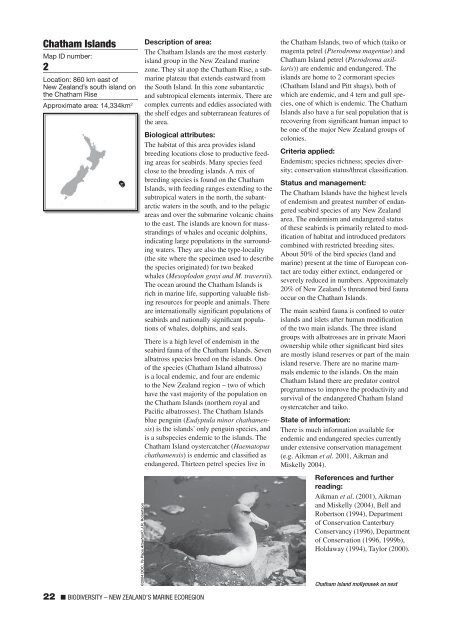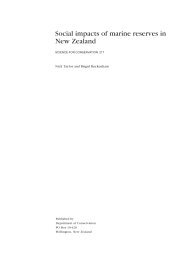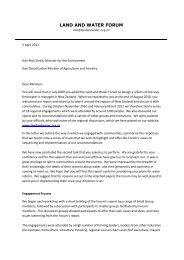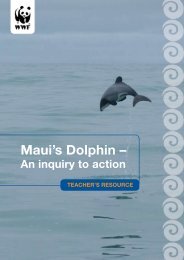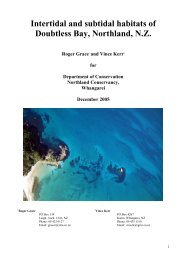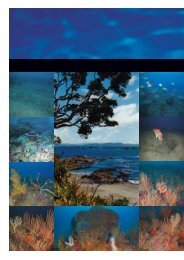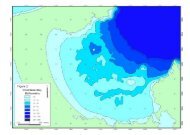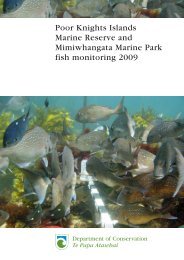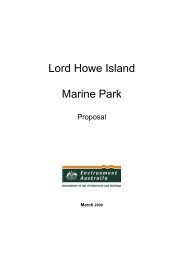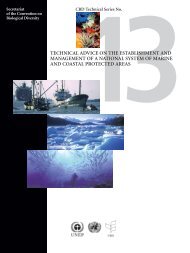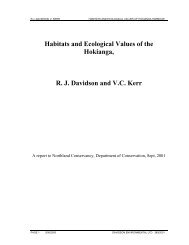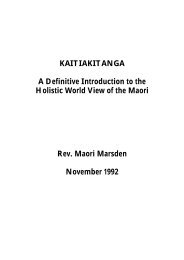WWF Shining a spotlight on the biodiversity of ... - MarineNZ.org.nz
WWF Shining a spotlight on the biodiversity of ... - MarineNZ.org.nz
WWF Shining a spotlight on the biodiversity of ... - MarineNZ.org.nz
You also want an ePaper? Increase the reach of your titles
YUMPU automatically turns print PDFs into web optimized ePapers that Google loves.
Chatham Islands<br />
Map ID number:<br />
2<br />
Locati<strong>on</strong>: 860 km east <strong>of</strong><br />
New Zealand’s south island <strong>on</strong><br />
<strong>the</strong> Chatham Rise<br />
Approximate area: 14,334km 2<br />
Descripti<strong>on</strong> <strong>of</strong> area:<br />
The Chatham Islands are <strong>the</strong> most easterly<br />
island group in <strong>the</strong> New Zealand marine<br />
z<strong>on</strong>e. They sit atop <strong>the</strong> Chatham Rise, a submarine<br />
plateau that extends eastward from<br />
<strong>the</strong> South Island. In this z<strong>on</strong>e subantarctic<br />
and subtropical elements intermix. There are<br />
complex currents and eddies associated with<br />
<strong>the</strong> shelf edges and subterranean features <strong>of</strong><br />
<strong>the</strong> area.<br />
Biological attributes:<br />
The habitat <strong>of</strong> this area provides island<br />
breeding locati<strong>on</strong>s close to productive feeding<br />
areas for seabirds. Many species feed<br />
close to <strong>the</strong> breeding islands. A mix <strong>of</strong><br />
breeding species is found <strong>on</strong> <strong>the</strong> Chatham<br />
Islands, with feeding ranges extending to <strong>the</strong><br />
subtropical waters in <strong>the</strong> north, <strong>the</strong> subantarctic<br />
waters in <strong>the</strong> south, and to <strong>the</strong> pelagic<br />
areas and over <strong>the</strong> submarine volcanic chains<br />
to <strong>the</strong> east. The islands are known for massstrandings<br />
<strong>of</strong> whales and oceanic dolphins,<br />
indicating large populati<strong>on</strong>s in <strong>the</strong> surrounding<br />
waters. They are also <strong>the</strong> type-locality<br />
(<strong>the</strong> site where <strong>the</strong> specimen used to describe<br />
<strong>the</strong> species originated) for two beaked<br />
whales (Mesoplod<strong>on</strong> grayi and M. traversii).<br />
The ocean around <strong>the</strong> Chatham Islands is<br />
rich in marine life, supporting valuable fishing<br />
resources for people and animals. There<br />
are internati<strong>on</strong>ally significant populati<strong>on</strong>s <strong>of</strong><br />
seabirds and nati<strong>on</strong>ally significant populati<strong>on</strong>s<br />
<strong>of</strong> whales, dolphins, and seals.<br />
There is a high level <strong>of</strong> endemism in <strong>the</strong><br />
seabird fauna <strong>of</strong> <strong>the</strong> Chatham Islands. Seven<br />
albatross species breed <strong>on</strong> <strong>the</strong> islands. One<br />
<strong>of</strong> <strong>the</strong> species (Chatham Island albatross)<br />
is a local endemic, and four are endemic<br />
to <strong>the</strong> New Zealand regi<strong>on</strong> – two <strong>of</strong> which<br />
have <strong>the</strong> vast majority <strong>of</strong> <strong>the</strong> populati<strong>on</strong> <strong>on</strong><br />
<strong>the</strong> Chatham Islands (nor<strong>the</strong>rn royal and<br />
Pacific albatrosses). The Chatham Islands<br />
blue penguin (Eudyptula minor chathamensis)<br />
is <strong>the</strong> islands’ <strong>on</strong>ly penguin species, and<br />
is a subspecies endemic to <strong>the</strong> islands. The<br />
Chatham Island oystercatcher (Haematopus<br />
chathamensis) is endemic and classified as<br />
endangered. Thirteen petrel species live in<br />
©2004 DOC, Te Papa Atawhai/C.J.R. Roberts<strong>on</strong><br />
<strong>the</strong> Chatham Islands, two <strong>of</strong> which (taiko or<br />
magenta petrel (Pterodroma magentae) and<br />
Chatham Island petrel (Pterodroma axillaris))<br />
are endemic and endangered. The<br />
islands are home to 2 cormorant species<br />
(Chatham Island and Pitt shags), both <strong>of</strong><br />
which are endemic, and 4 tern and gull species,<br />
<strong>on</strong>e <strong>of</strong> which is endemic. The Chatham<br />
Islands also have a fur seal populati<strong>on</strong> that is<br />
recovering from significant human impact to<br />
be <strong>on</strong>e <strong>of</strong> <strong>the</strong> major New Zealand groups <strong>of</strong><br />
col<strong>on</strong>ies.<br />
Criteria applied:<br />
Endemism; species richness; species diversity;<br />
c<strong>on</strong>servati<strong>on</strong> status/threat classificati<strong>on</strong>.<br />
Status and management:<br />
The Chatham Islands have <strong>the</strong> highest levels<br />
<strong>of</strong> endemism and greatest number <strong>of</strong> endangered<br />
seabird species <strong>of</strong> any New Zealand<br />
area. The endemism and endangered status<br />
<strong>of</strong> <strong>the</strong>se seabirds is primarily related to modificati<strong>on</strong><br />
<strong>of</strong> habitat and introduced predators<br />
combined with restricted breeding sites.<br />
About 50% <strong>of</strong> <strong>the</strong> bird species (land and<br />
marine) present at <strong>the</strong> time <strong>of</strong> European c<strong>on</strong>tact<br />
are today ei<strong>the</strong>r extinct, endangered or<br />
severely reduced in numbers. Approximately<br />
20% <strong>of</strong> New Zealand’s threatened bird fauna<br />
occur <strong>on</strong> <strong>the</strong> Chatham Islands.<br />
The main seabird fauna is c<strong>on</strong>fined to outer<br />
islands and islets after human modificati<strong>on</strong><br />
<strong>of</strong> <strong>the</strong> two main islands. The three island<br />
groups with albatrosses are in private Maori<br />
ownership while o<strong>the</strong>r significant bird sites<br />
are mostly island reserves or part <strong>of</strong> <strong>the</strong> main<br />
island reserve. There are no marine mammals<br />
endemic to <strong>the</strong> islands. On <strong>the</strong> main<br />
Chatham Island <strong>the</strong>re are predator c<strong>on</strong>trol<br />
programmes to improve <strong>the</strong> productivity and<br />
survival <strong>of</strong> <strong>the</strong> endangered Chatham Island<br />
oystercatcher and taiko.<br />
State <strong>of</strong> informati<strong>on</strong>:<br />
There is much informati<strong>on</strong> available for<br />
endemic and endangered species currently<br />
under extensive c<strong>on</strong>servati<strong>on</strong> management<br />
(e.g. Aikman et al. 2001, Aikman and<br />
Miskelly 2004).<br />
References and fur<strong>the</strong>r<br />
reading:<br />
Aikman et al. (2001), Aikman<br />
and Miskelly (2004), Bell and<br />
Roberts<strong>on</strong> (1994), Department<br />
<strong>of</strong> C<strong>on</strong>servati<strong>on</strong> Canterbury<br />
C<strong>on</strong>servancy (1996), Department<br />
<strong>of</strong> C<strong>on</strong>servati<strong>on</strong> (1996, 1999b),<br />
Holdaway (1994), Taylor (2000).<br />
Chatham Island mollymawk <strong>on</strong> nest<br />
22 ■ BIODIVERSITY – NEW ZEALAND’S MARINE ECOREGION


